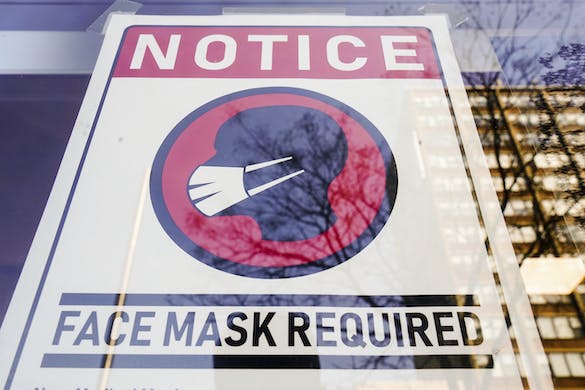Questions Swirl Around Wisdom, Timing of Recent CDC Guidelines
Only 44 percent of Americans trust the CDC, according to a January 2022 NBC News poll, down from 69 percent in April 2020.

As parents in the age of Covid worry about the effects of masking, remote schooling, and social isolation on their children, federal health officials have raised red flags by lowering several milestones for early-language and other development.
The Centers for Disease Control and the American Academy of Pediatrics in February published revisions to the Learn the Signs. Act Early program, a checklist of critical milestones for infants and young children. The “most alarming” change, according to a speech pathologist, Ashley Northam, is the age at which “normal” children should speak a minimum of 50 words.
The American Speech-Language-Hearing Association, the accrediting body for speech language pathologists, says that milestone is 24 months, while the CDC’s checklist now says it should be achieved at 30 months.
Ms. Northam told the Sun developmentally “normal” children should speak 450 words by 30 months. Between 24 and 30 months is when language development explodes, and by following the new CDC guidelines, “we will have missed out on critical time to provide intervention,” she said.
ASHA released a statement in response to the CDC, “expressing its concern” that “the milestones presented to parents must be evidence-based,” seemingly a measured way of saying the CDC got this wrong.
Only 44 percent of Americans trust the CDC, according to a January 2022 NBC News poll, down from 69 percent in April 2020.
“Instead of highlighting the harmful effects of masking & social isolation have had on small children the CDC just lowered the bar,” Megyn Kelly retweeted on February 19, and added her own commentary: “This is sick. What the hell is wrong with @CDCDirector?”
The CDC responded to ASHA’s concerns in a call with ASHA leaders on February 28. The CDC told the Sun via email that it has “not lowered the standards” and that the milestones “are not intended to be used for evaluation/qualification of a child for services.”
Some consider the timing of the CDC’s new milestones clumsy at best. “You would think a global pandemic with widespread masking would make them pause and reassess the best way forward instead of plow ahead with guidance that—just a fact—lowers the threshold of concern,” Dr. Vinay Prasad tweeted to his 180,000 followers.
In a Twitter thread that went viral, a literacy consultant, Karen Vaites, also questioned the CDC’s decision to lower developmental milestones at this moment, though she doesn’t share the opinion floated on social media that this is a CDC coverup of Covid-related developmental delays. “I don’t trade in conspiracy theories. I try to trade in facts,” she told the Sun. But she chastised “doctors who cheer” the guidance “just to stick to a position in the Mask Wars.”
Ms. Vaites is a vocal opponent of masking young children in schools. The political dividing line on masks infuses every debate now about CDC guidance.
On Friday, the CDC lifted its indoor mask recommendation for 70 percent of the U.S. population, including in schools. For many early childhood development experts and parents concerned about masking’s impact on speech and reading, the CDC’s mask announcement didn’t come soon enough.
Amplify, a curriculum and assessment provider, recently released a report showing that while 29 percent of kindergartners were considered “far behind” in literacy skills pre-pandemic, that number jumped to 47 percent and 37 percent for the first and second years of Covid. In January, the CDC released an update saying masks with a clear plastic panel over the mouth “may be helpful” to “young children or students learning to read.”
The new CDC early development guidelines, which the AAP started drafting before the pandemic, include motor skills, language development, social-emotional and cognitive behaviors that children from birth to age 5 should be expected to reach at certain times. The CDC formerly set its benchmarks at the 50th percentile, meaning at what the average child should be able to do. The new guidelines set benchmarks that all but the lowest 25 percent should achieve. They are therefore lower, and those who don’t meet them are no longer considered just below average, but developmentally delayed.
The idea is “to make it easier to identify the kids in need of some kind of early intervention,” a Brown University economist and author of several data-driven parenting books, Emily Oster, told the Sun. Even with this new framework, though, there are “legitimate concerns” that “they draw the line too low,” Dr. Oster concedes.
Are young children experiencing developmental delays during Covid? Studies from Columbia and Brown universities do show significantly lower fine and gross motor skills and IQ scores in babies born during the pandemic, regardless of exposure to Covid. But Dr. Oster cautions against reading too much into these, as, at least in the Brown study, the researchers wore masks to interact with the infants, making “comparison across time kind of suspect.” She predicts more rigorous studies will be published in the coming years, and that the real effects of the pandemic and Covid-related measures are “an open question.”
One thing is clear: The politicization of public health has rendered all CDC guidance suspect to more than half the country.
This article was updated with a response from the CDC.

